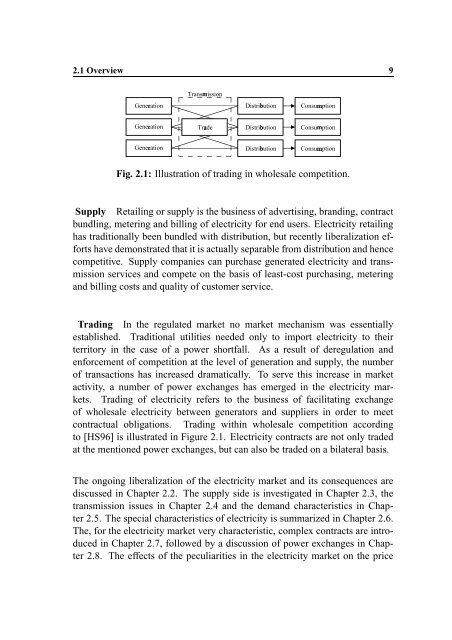Hedging Strategy and Electricity Contract Engineering - IFOR
Hedging Strategy and Electricity Contract Engineering - IFOR
Hedging Strategy and Electricity Contract Engineering - IFOR
Create successful ePaper yourself
Turn your PDF publications into a flip-book with our unique Google optimized e-Paper software.
2.1 Overview 9<br />
Generation<br />
¥<br />
Distribution<br />
¦<br />
Consum§ ption<br />
Transm§ ission<br />
Generation<br />
¥<br />
Träde<br />
Distribution<br />
¦<br />
Consum§ ption<br />
Generation<br />
¥<br />
Distribution<br />
¦<br />
Consum§ ption<br />
Fig. 2.1: Illustration of trading in wholesale competition.<br />
Supply Retailing or supply is the business of advertising, br<strong>and</strong>ing, contract<br />
bundling, metering <strong>and</strong> billing of electricity for end users. <strong>Electricity</strong> retailing<br />
has traditionally been bundled with distribution, but recently liberalization efforts<br />
have demonstrated that it is actually separable from distribution <strong>and</strong> hence<br />
competitive. Supply companies can purchase generated electricity <strong>and</strong> transmission<br />
services <strong>and</strong> compete on the basis of least-cost purchasing, metering<br />
<strong>and</strong> billing costs <strong>and</strong> quality of customer service.<br />
Trading In the regulated market no market mechanism was essentially<br />
established. Traditional utilities needed only to import electricity to their<br />
territory in the case of a power shortfall. As a result of deregulation <strong>and</strong><br />
enforcement of competition at the level of generation <strong>and</strong> supply, the number<br />
of transactions has increased dramatically. To serve this increase in market<br />
activity, a number of power exchanges has emerged in the electricity markets.<br />
Trading of electricity refers to the business of facilitating exchange<br />
of wholesale electricity between generators <strong>and</strong> suppliers in order to meet<br />
contractual obligations. Trading within wholesale competition according<br />
to [HS96] is illustrated in Figure 2.1. <strong>Electricity</strong> contracts are not only traded<br />
at the mentioned power exchanges, but can also be traded on a bilateral basis.<br />
The ongoing liberalization of the electricity market <strong>and</strong> its consequences are<br />
discussed in Chapter 2.2. The supply side is investigated in Chapter 2.3, the<br />
transmission issues in Chapter 2.4 <strong>and</strong> the dem<strong>and</strong> characteristics in Chapter<br />
2.5. The special characteristics of electricity is summarized in Chapter 2.6.<br />
The, for the electricity market very characteristic, complex contracts are introduced<br />
in Chapter 2.7, followed by a discussion of power exchanges in Chapter<br />
2.8. The effects of the peculiarities in the electricity market on the price
















